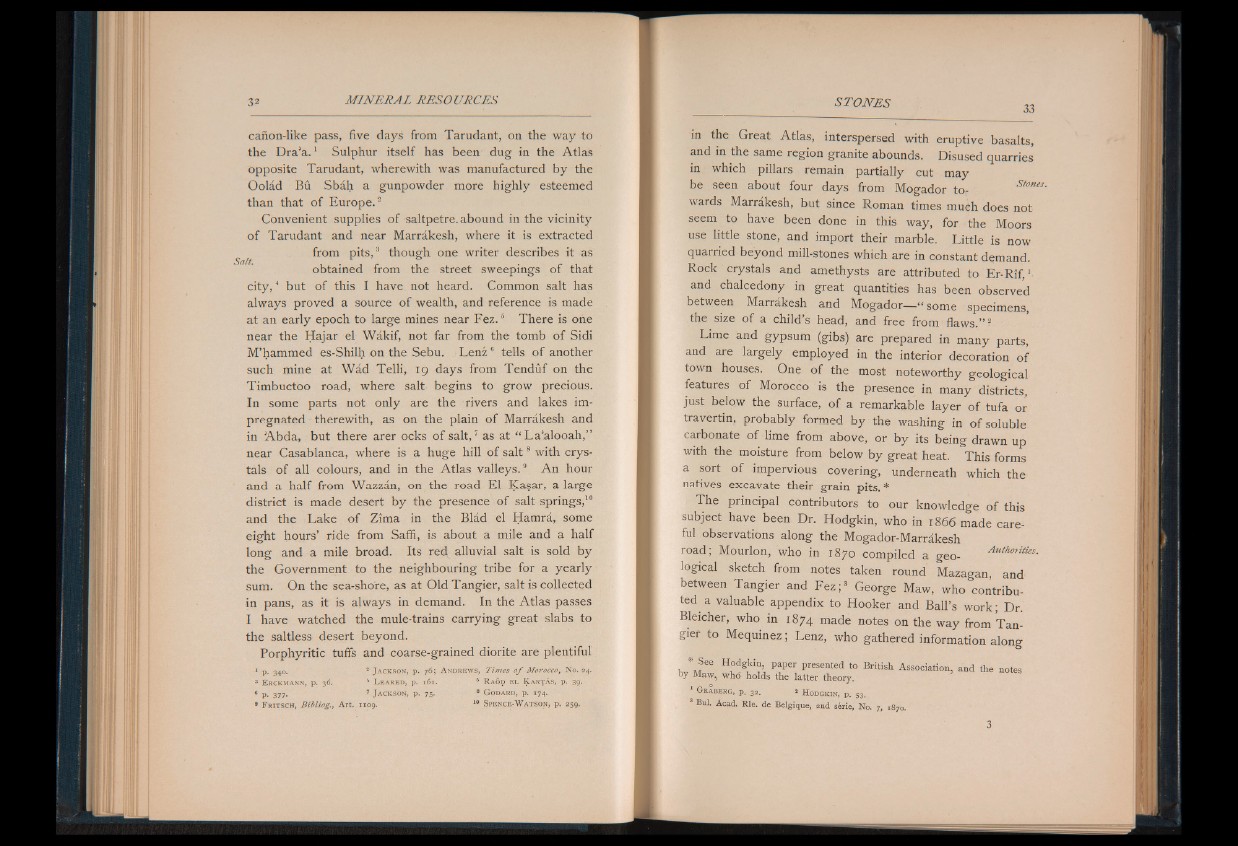
canon-like pass, five days from Tarudant, on the way to
the Dra'a.1 Sulphur itself has been dug in the Atlas
opposite Tarudant, wherewith was manufactured by the
Oolad Bu Sbah a gunpowder more highly esteemed
than that of Europe.2
Convenient supplies of saltpetre, abound in the vicinity
of Tarudant and near Marrakesh, where it is extracted
from pits, 3 though, one writer it . describes it as obtained from the street sweepings of that
c ity ,4 but of this I have not heard. Common salt has
always proved a source of wealth, and reference is made
at an early epoch to large mines near F e z .5 There is one
near the Hajar el Wakif, not far from the tomb of Sidi
M’hammed es-Shilh on the Sebu. L en z6 tells o f another
such mine at Wad Telli, 19 days from Tenduf on the
Timbuctoo road, where salt begins to grow precious.
In some parts not only are the rivers and lakes impregnated
therewith, as on the plain o f Marrakesh and
in Abda, but there arer ocks of salt,7 as at “ La'alooah,”
near Casablanca, where is a huge hill of s a lt8 with crystals
of all colours, and in the Atlas valleys.9 An hour
and a half from Wazzan, on the road El Kasar, a large
district is made desert by the presence o f salt springs,10
and the Lake of Zima in the Blad el Hamra, some
eight hours’ ride from Saffi, is about a mile and a half
long and a mile broad. Its red alluvial salt is sold by
the Government to the neighbouring tribe for a yearly
sum. On the sea-shore, as at Old Tangier, salt is collected
in pans, as it is always in demand. In the Atlas passes
I have watched the mule-trains carrying great slabs to
the saltless desert beyond.
Porphyritic tuffs and coarse-grained diorite are plentiful
1 p. 340. 2 J a c k s o n , p. 76 ; A n d r e w s , Times o f Morocco, No. 24.
3 E r c km a n n , p . 36. * L e a r e d , p . 16 1 . 5 R a o d e l K a r t a s , p. 39.
8 P* 377- 7 J a c k s o n , p . 75 . 8 G o d a r d , p . 174.
9 F r i t s c h , Bibliog.y Art. 1109 . 10 S p e n c e -W a t s o n , p. 259.
in the Great Atlas, interspersed with eruptive basalts,
and in the same region granite abounds. Disused quarries
in which pillars remain partially cut may
be seen about four days from Mogador to- Stones‘
wards Marrakesh, but since Roman times much does not
seem to have been done in this way, for the Moors
use little stone, and import their marble. Little is now
quarried beyond mill-stones which are in constant demand.
Rock crystals and amethysts are attributed to Er-Rif,1
and chalcedony in great quantities has been observed
between Marrakesh and Mogador— “ some specimens,
the size of a child’s head, and free from flaws. ” ?
Lime and gypsum (gibs) are prepared in many parts,
and are largely employed in the interior decoration of
town houses. One of the most noteworthy geological
features of Morocco is the presence in many districts,
just below the surface, o f a remarkable layer o f tufa or
travertin, probably formed by the washing in o f soluble
carbonate of lime from above, or by its being drawn up
with the moisture from below by great heat. This forms
a sort o f impervious covering, underneath which the
natives excavate their grain pits. *
The principal contributors to our knowledge o f this
subject have been Dr. Hodgkin, who in 1866 made careful
observations along the Mogador-Marrâkesh
road; Mourlon, who in 1870 compiled a geo- A” thotitks.
iogical sketch from notes taken round Mazagan, and
between Tangier and F e z ;3 George Maw, who contributed
a valuable appendix to Hooker and Ball’s work ; Dr.
Bleicher, who in 1874 made notes on the way from Tangier
to Mequinez ; Lenz, who gathered information along
JBH ËBpSi PaPer Presented to British Association, and the notes
by Maw, who holds the latter theory.
G r a b e r g , p . 3 2 . * H o d g k i n , p . 5-3.
3 Bui. Acad. Rie. de Belgique, 2nd série, No. 7, 1870.